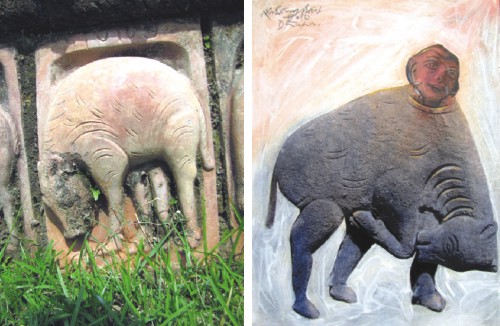| Heritage
Retelling Lost History
The golden history of Bengali heritage is on the brink of oblivion due to inadequate conservation policies and the apathy of the masses. The Heritage Show 2010 on December 9, 10 and 11 aims to rekindle the pride and glory by staging arts and sculptures with essences of the ancient Bengal
AANTAKI RAISA
The Pala Dynasty, often considered as the Roman Empire of Bengal, marks the zenith of political dominance, cultural growth and educational advancement of our history. Mahayana Buddhism introduced by the Palas became an international force, extending its influence to Tibet and the Malaya peninsula. During their reign from 750 to 1174 AD, Palas constructed many Buddhist Viharas (high schools/colleges) in Bengal where subjects like philosophy, astronomy, religion, language and literature were taught. More than 7000 sramanas (students) from home and abroad studied there. One such, the Paharpur of Naogaon, built by the Pala king Dharmapala in 800A.D. was one of the largest monasteries in the subcontinent. This monumental residential academic centre, built on an area of 27 acres, served as the academia for legends like Hiuen Tsang. It's noteworthy that, during that time, in the 8th century AD, the West didn't have their much celebrated Oxford or Cambridge; in fact, the British Empire was still in its dark ages while the Bengal civilisation was flourishing lavishly. Unfortunately, the present generation barely knows anything about such glorious heritage of ours. A more threatening fact is that the last vestiges of our heritage are on the verge of extinction due to the lack of prudent preservation tactics. The 'Heritage Show 2010' organised by the Arts Council Dhaka is an effort to enlighten the nation about its past glory.

L-R: Terracotta Plaque, Paharpur Vihara. Encaged woman ,
depicted by Mustafa Jamil Akbar.
According to Mustafa Jamil Akbar Shamim, one of the senior artists of the heritage show, the Pala Dynasty was a golden age in the history of Bengal civilisation. “The first Bengali scripture was written during this time. And the artwork on terracotta plaques of Paharpur are extremely detailed and powerful, ” he says. “The Arts Council Dhaka endeavours to spread the majestic saga of our civilisation and what could be better than the Pala Dynasty to start with? ” he adds. Shamim believes that such an arrangement will help raise awareness among the public and the respective authority to protect and preserve our national heritage. “When we went to visit the spot, I saw replicas of terracotta plaques on the walls of the monument. To preserve the original artefacts, the authority hired local artists and laymen to make the replacements instead of hiring specialists; as a result there were plaques depicting camels and oil lamps, which never were part of the Pala Dynasty! There were even missing terracotta plaques; the plaques were arranged in a manner to tell the story of that time but now that they are missing, the stories cannot be depicted,” he states. “It's sad to see such artistic marvels disappearing just because of negligence and ignorance,” he adds.
The Arts Council Dhaka aims to appeal to the public by blending the craft of the past with the realism of the present. Forty participants of the heritage show from Dhaka and Rajshahi studied the arts and crafts of the Pala period for three months and experimented with fibreglass, metals and terracotta to create unorthodox mixed-media paintings and sculptures. “Our artists went through painstaking experimentations to create awe-inspiring art pieces. We studied a lot about our concepts and tried to make something new out of it. Like the terracotta plaques, our art pieces reveal a story or convey a message,” Shamim says while explaining the individuality of the exhibition. Shamim opines such opportunity will inspire the up- coming artists to experiment with eccentric contrasts. The exhibition itself opens a new arena of fusion where tradition meets contemporary art.
|
Original Pala Art . The lost story of Paharpur , depicted by Mustafa Jamil Akbar. Photo: Arts Council Dhaka |
“We plan to organise a series of such exhibitions depicting the history of Bengali heritage. We are starting with the Palas and hope to conclude the course with the contemporary realm,” affirms Shamim. He hopes that their efforts will start a mass awareness about the importance of knowing, preserving and protecting these priceless treasures.
The history of Bengal possesses a heritage of thousands of years, most of it symbolising a rich, creative past. Seventeen different civilisations have been established in the Mahasthangarh beside the river Korotowa; no other territory in the world has been endowed with so many civilisations. Our heritage is a rich legacy of many more singularities like this. The Bengal history is the valour of the Aryans, the proud tale of the Mouryans, the meticulous craftsmanship of the Guptas, the grandeur of the Sultanate Empire, the magnificence of the Mughal monuments. A dive into our glorious past will surely inspire us to reflect that splendour on our present and future.
The Heritage Show 2010 will take place at 12 North Gulshan Avenue at 5 pm.
Copyright
(R) thedailystar.net 2010 |
|
